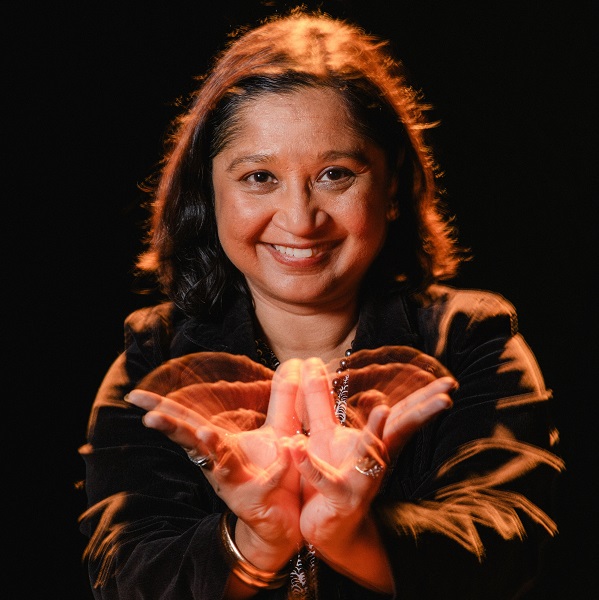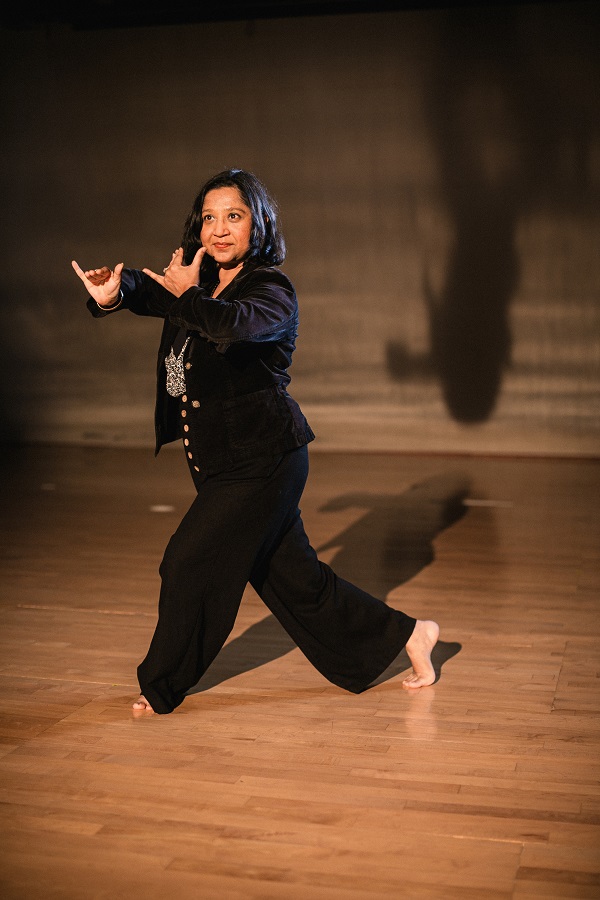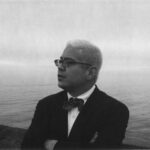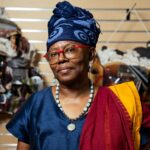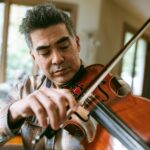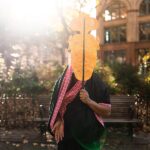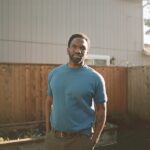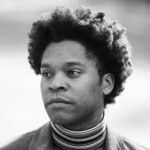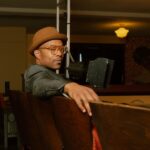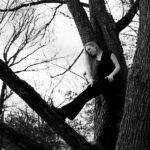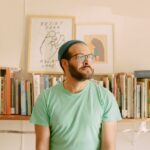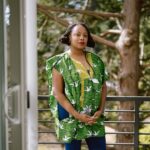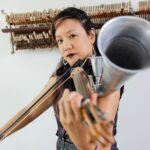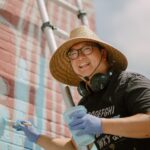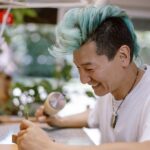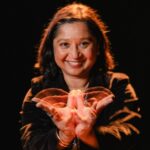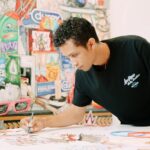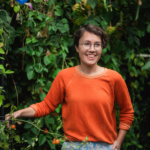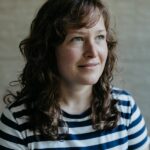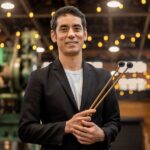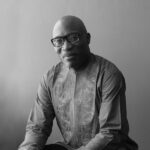The Language of Dance
Written by Putsata Reang; Photographed by Jason Quigley
I. NRITA. Pure dance, rhythmic movement; one of three distinct elements of a Bharatanatyam repertoire.
In the soul of Subashini Ganesan-Forbes, silence stirs. She moves to the music of a beating heart. Step. Gesture. Step. An arced palm flips towards earth; a leg lifts, toes tipped, pointed toward heaven. Gesture by gesture, a story unfolds.
Subashini is a master of Bharatanatyam, the traditional dance of her South Asian ancestors that originated in the Hindu temples of the Tamil Nadu region of India, in which emotion, melody, and rhythm combine with movement to summon the gods—and which Subashini has contemporized by dancing (at times) without music, by collaborating with dancers in other genres, and by allowing her body to extend particular moves as she explores the complexities and most urgent messages of the moment.
What feels pressing to Subashini lately are the ways in which American culture is being bruised by division, by book bans and gender rights fights and access to the arts. The world is wounding. And so, to watch Subashini move is to be taken back to the foundations of being. She believes art has the power to wick away pain, if only for moments—a gesture, a song—at a time.
“How can arts and culture play an important role in the healing of relationships?” Subashini often wonders. “How far can we take this experiment of communal humanity so that we can all flourish?”
To be sure, dance was never meant as a platform for political expression for Subashini, although she believes that to be an artist is to inherently be an advocate, which itself veers political. Instead, for Subashini, dance has always been a personal imperative and a public invitation into a certain bliss of being, attainable when the body bends in measured manners, opening the path to a particular grace.
“Dance is my oxygen,” Subashini says. “The discipline of the dancer allows me to go places that are both deep and expansive. I’m in a world of freedom that can only come through that language of movement.”
II. NRITYA. In Bharatanatyam, a solo dance with dramatic aspects.
But freedom carries a cost. When she was four years old, Subashini’s mother led her to her future by bringing her to Bhasker’s Dance Academy in Singapore, where Subashini was born and raised. When she was five years old, Subashini performed her first public dance.
Forty-five years later, she hasn’t stopped dancing, despite the ways in which her artistic pursuits disrupted a delicate family structure where dance was meant to help make girls marketable for marriage, to augment an education and a career, rather than be the career.
Subashini tried to conform. She studied genetics at the University of Rochester and considered becoming a scientist after graduating with degrees in biology and religion. She worked in public policy around pay equity and corporate accountability in Washington D.C. before moving to Portland in 2001, where she worked for Equal Exchange promoting fair trade coffee. Dance was always in the background.
Continue Reading
It wasn’t until 2008, a year after her father died, that Subashini says she “arrived into myself,” and began to foreground her creative impulses. Instead of agreeing to an arranged marriage, she met her husband at a Tango Milonga. Instead of committing to a career in science, she plunged headlong into dance.
“It created strife in my family, walking this unconventional path,” Subashini says.
Throughout her lifetime, her paternal grandmother loved and supported Subashini through that strife.
“I would not be alive if she did not love me in the way she did…through all the confusion of what families look like.”
When Subashini moved to Portland for a second time, in 2008, she arrived with the goal of opening a small dance studio to share her passion for Bharatanatyam. She started with a 450-square-foot space in Southeast Portland, before a modern dance company vacated the building, creating an opportunity to expand.
“I thought, ‘If I’m going to take over, what more can the space do for dance beyond me?’” Subashini says. “That space needed to be meaningfully shared.”
She signed a lease, ignoring the suspicions of some white dancers who openly worried Subashini would transform the dance space into a yoga studio, and started her nonprofit organization, New Expressive Works (NEW), a performance venue where she teaches and mentors the next generation of dancers and choreographers.
“When you say, ‘dance,’ the general public, they’re thinking ballet, modern dance. They aren’t thinking global,” Subashini says. “I started to think, ‘What does it look like when someone like me, who is not Western-trained, becomes a person who stewards a space, a community, for dance as a larger thing?’”
III. NATYA. A combination of nrita and natya, or group dramatic dance.
NEW has become a hub for multicultural choreographers and dancers to incubate new ideas. The venue is built around a residency program that has helped more than fifty choreographers at different stages of their careers develop and exhibit new work with the support of hundreds of dancers, technicians, and set, sound, and costume designers.
Even as she leads one of the Northwest’s most exciting community dance initiatives, Subashini continues to move in multiple universes. She juggles roles as advocate, administrator, ambassador, teacher, and relentless truth-seeker. She is the new chair of the Oregon Arts Commission, and a former Creative Laureate of the City of Portland. She is a collaborator, developing works for the Portland Opera, Middlebury College, and University of Oregon, and working with Mike Barber of Ten Tiny Dances; Michelle Fujii of Unit Souzou; Amna Mawaz Khan (Pakistan/Germany); Northwest Folklife Festival in Seattle; and Portland Center Stage, among others. And she teaches arts advocacy at Pacific University while serving on a long roster of arts-related boards and commissions, locally and statewide.
At her cultural core, Subashini is Tamil, specifically Brahmin. She is Singaporean of South Asian descent, born first of two daughters to an engineer father and a stay-at-home mother. Hers was a family of leavers: her paternal grandfather left India for Malaysia with his wife; her father left Malaysia for Singapore, where her mother joined; and then Subashini left Singapore for the U.S., where she ranged from New York to Hawaii before finding a foothold in Portland.
“There is intersectionality of all the things I am,” Subashini says. “I’m not satisfied in only being an artist.”
Subashini credits a handful of dance teachers and arts advocates, and her husband, Scott, for making her the dancer and the human she is.
Vasanti Jayaswal, a Sanskrit scholar and Subashini’s mentor, gifted her an early Sanskrit manuscript of the Twenty-One Praises to Arya Tara, which was foundational for Subashini, and which inspired one of her earliest contemporary dance works. Dr. Douglas R. Brooks, a Harvard professor and scholar of Hinduism and South Asian languages, provided Subashini both intellectual and cultural mentorship. And Scott has been a constant source of deep connection. You can often find the couple at Division Wines, or Coquine, a neighborhood nook near the city’s famed Mt. Tabor, where Subashini orders the four-course pescatarian dinner. You might also catch her rotating among the many arts events and performances in town, or at the Japanese Garden. She loves visiting at different times of the year, when plants don new hues, evolving with the environment. Which is what Subashini has learned to also do.
“I’m growing with my body and growing with the dance,” Subashini says. “If I can be true–” to the form, to herself—“dance changes with me.”

